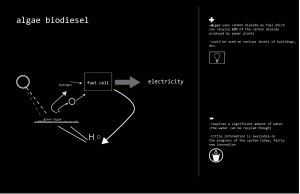Algae Cultivation
Framework
As the world’s energy demand continues to rise, there exists a concurrent increase in greenhouse gas emissions stemming from fossil fuels consumption. As a result a need for renewable energy sources is rapidly expanding. Biofuels represent a large segment for potential energy, but as ethanol has demonstrated, finding an energy source that doesn’t compete with our food supply (and is sustainably cultivated) has become paramount. Algae cultivation has the potential to produce large amounts of fuel produced in a suitable manner.
Louisiana’s shorelines, both oceanside and lakeside, offer great conditions for algae farming. The key ingredients: carbon dioxide, light, basic nutrients, and open water are found in the Gulf of Mexico as well as Lake Pontchartrain. Algae are naturally occurring, but is most noticed during algal blooms when algae flourish under nutrient rich conditions.
Process
Algae convert sunlight into energy via the process of photosynthesis, whereby carbon dioxide + light = glucose + oxygen. In addition algae quickly reproduce, allowing for harvest in as little as 10 days. When compared to corn growth cycles (used for ethanol production) it is clear that algae are superior for fuel production.
Algae can be cultivated in:
PhotoBioreactors: Where nutrient filled water is pumped through “bioreactors”, plastic tubes that are then exposed to sunlight to allow photosynthesis to occur.
Closed Loop Systems: Are expensive because they require heavy infrastructural costs. They are designed to isolate the algae, and feed pollutant-free, pure CO2, usually from a smokestack.
Open Ponds: Are extremely hard to cultivate because they deal with many outside forces, precisely those that the closed loop system is designed to eliminate. Elements like, change in water temperature and PH levels, competition from other algae, and the exposure to bacteria, make the process of cultivating in an Open Pond, extremely difficult, with high variance algae biofuel extracted.
Experience
Algae cultivation interacts with the larger environment in a positive manner by creating a carbon neutral energy supply. What carbon dioxide is released from the burning of the algae fuel is offset from the carbon dioxide that algae absorb during the photosynthesis process.
Algae cultivation can also result in the rebirth of waterfront locations, allowing for redevelopment of stagnant industrial areas into corridors of renewable energy production.
*sources for the above information come from wikipedia http://en.wikipedia.org/wiki/Algae_fuel#Algae_cultivation, http://en.wikipedia.org/wiki/Algaculture, and oil algae.com http://www.oilgae.com/algae/algae.html

